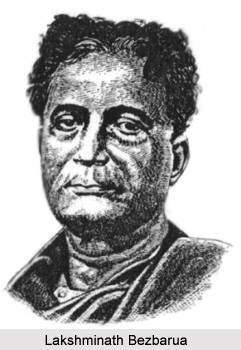 Jonaki era is also known as the age of Romanticism in Assamese literature. Though by 1889 the Romantic age had long faded in English literature, the Romantic ideal appealed, and was most applicable, to writers of an emergent literature. Their predecessors had given them their voice, and writers of this era used it to express a wide range of issues through a variety of forms. Jonaki was an early and important vehicle for this expression. First published on February 9, 1889, by Chandrakumar Agarwala, it was the journal of the Asamiya Bhashar Unnati Sadhini Sabha (Society for the Development of the Assamese Language), a society that included later Jonaki editors Lakshminath Bezbarua and Hemchandra Goswami.
Jonaki era is also known as the age of Romanticism in Assamese literature. Though by 1889 the Romantic age had long faded in English literature, the Romantic ideal appealed, and was most applicable, to writers of an emergent literature. Their predecessors had given them their voice, and writers of this era used it to express a wide range of issues through a variety of forms. Jonaki was an early and important vehicle for this expression. First published on February 9, 1889, by Chandrakumar Agarwala, it was the journal of the Asamiya Bhashar Unnati Sadhini Sabha (Society for the Development of the Assamese Language), a society that included later Jonaki editors Lakshminath Bezbarua and Hemchandra Goswami.
The term "Romantic" itself is used by Assamese writers and critics and implies the same approach to literature as it does in English literature. It would not be correct to say that writers of this era imitated Wordsworth, Shelley, or Keats; rather, they were strongly influenced by the Romantic sensibilities of these English poets. It is fitting that Assamese writers of this period would look to the Romantics rather than their contemporary Victorians. Assam was still untouched by industrialization and urbanization; the natural landscape held much scope for literary exploration, and the literary climate was full of promise and possibilities.
The lyric and ballad forms were extensively used in the literature of this period. There was the focus on man and his relation to nature, beauty and the arts. In his introduction to `Kuri Satikar Asamiya Kabita` (Twentieth-Century Assamese Poetry), the poet `Nilamoni Phookan` aptly sums up romantic poetry as a movement away from theo-centrism to anthropo-centrism. The central theme changed from devotion to God to devotion to the world, its beauties, man as a reflection of the supernatural, and man`s pursuit of joy and beauty.
However, this was still a literature of the early twentieth century and could not be totally divorced from modernity. The acceleration of the independence movement and the social and cultural reformation movements in Bengal and other parts of the country influenced it and made it also a literature that examined social and nationalist issues. During this period the Asom Sahitya Sabha (Assam Literary Association) was formed in 1917. The Sahitya Sabha facilitated the exchange of ideas, popularized Assamese literature, art, and culture, and provided a forum for literary debate and discussion through its conventions, journals, and publications. It continues to be the primary literary association for the state even today.



















